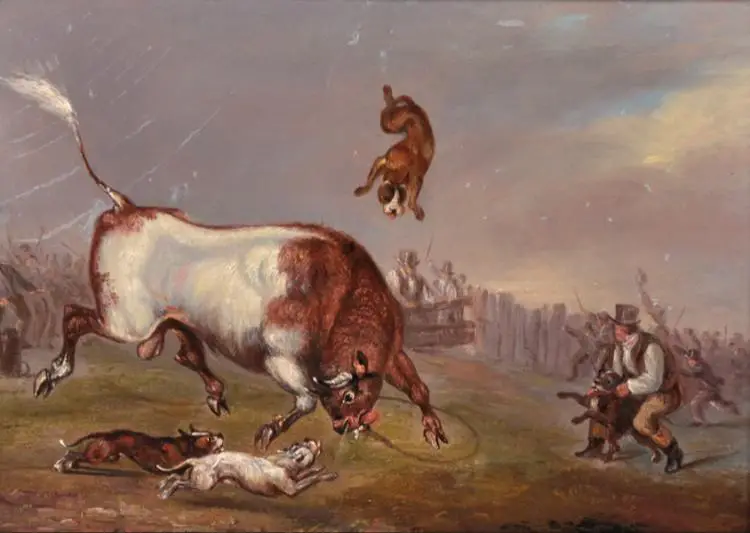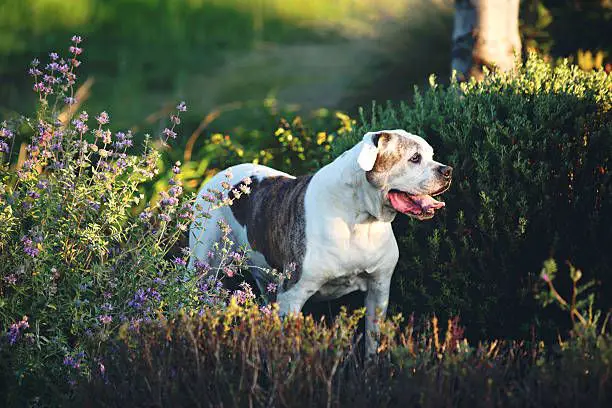Introduction
The history of the Pit Bull breed can be traced back to the early 1800s in the United Kingdom, where they were originally bred from Old English Bulldogs. Pit Bulls were used in the sport of bull baiting, which involved pitting dogs against bulls. Once bull baiting was banned in 1835, Pit Bulls were then bred for dog fighting and ratting. Immigrants later brought Pit Bulls to America, where they continued to be used as working dogs on farms and ranches. https://love-a-bull.org/resources/the-history-of-pit-bulls/
The American Bulldog breed has roots tracing back to 17th century England, where they descended from Old English Bulldogs. American Bulldogs were brought to the American South in the 18th century to work on farms and help hunt and drive livestock. Here they were further developed as a distinct breed. The American Bulldog nearly went extinct in the early 20th century, but efforts by John D. Johnson helped revive the breed. https://www.sparkpaws.com/blogs/community/difference-between-pit-bulls-and-american-bulldogs
While Pit Bulls and American Bulldogs do share some ancestry in the Old English Bulldog, they diverged into distinct breeds through selective breeding for different purposes. There is often confusion around their relationship and origins due to some similarities in appearance and shared Bulldog lineage.
Origins of the Pitbull

The origins of the Pitbull breed can be traced back to the early 1800s in the United Kingdom. Pitbulls were originally bred from Old English Bulldogs and Old English Terriers [1]. The purpose was to develop a breed that combined the gameness and agility of the terrier with the strength and athleticism of the bulldog. This mix was intended to produce a canine suited for the cruel, bloody sport of bull-baiting, which involved pitting dogs against bulls.
Later, when bull-baiting was outlawed in the UK in 1835, these dogs were then used for dog fighting and ratting competitions. To enhance their fighting abilities, some bulldog and terrier breeds were crossed to produce the Bull and Terrier breeds. Immigrants eventually brought some of these dogs to the United States where they continued to be used in dog fighting.
In the late 1800s, the Pitbull was specifically bred in the US as the “American Pit Bull Terrier” by breeding the Bull and Terrier dogs with Terriers imported from Ireland and England. Over time, the Pitbull developed into a muscular, loyal, and intelligent breed known for its strength, confidence and bravery [2].
Origins of the American Bulldog
The American Bulldog originated in the rural areas of the American South as a working farm dog. They are believed to be descended from Old English Bulldogs brought to America in the 17th and 18th centuries. These dogs were used for guarding property, helping move cattle, and other farm-related work.
Some of the earliest documentation of the American Bulldog comes from a book published in 1927 called American Bulldogs by John D. Johnson, a longtime breeder in Summerville, Georgia. Johnson talked about four different types of regional bulldog breeds found on farms in the South, which formed the early foundation stock of the American Bulldog we know today.
By the end of World War II, working farm dogs like the American Bulldog had declined sharply in popularity. However, some breeders like Johnson, Allan Scott, and others worked to keep the breed alive. Through selective breeding programs, they resurrected the American Bulldog and eventually established a formal breed standard in the 1970s. Today the American Bulldog continues to be an athletic, rugged dog with strong working abilities.
Sources:
https://www.akc.org/dog-breeds/american-bulldog/
http://www.ababulldogs.com/history.html
Shared Ancestry

Both the American Pit Bull Terrier and the American Bulldog share ancestry from the Old English Bulldog breed. This was an athletic and muscular working dog used for bull baiting in England until the practice was banned in 1835. When bull baiting was outlawed, these dogs were then used for dog fighting and as guard dogs in England and America.
In the late 1800s, English Bulldogs were crossed with Terriers to create a smaller and more agile fighting dog, now known as the Pit Bull. Meanwhile, the American Bulldog remained closer to its Old English Bulldog roots, but some breeding with other working farm dogs produced a more athletic version suited for hunting, guarding, and working livestock in America.
So while the Pit Bull and American Bulldog have a common ancestor in the Old English Bulldog, selective breeding in the last 200 years has differentiated them into distinct modern breeds. The Pit Bull tends to be smaller, while the American Bulldog is larger with a more Bulldog-like head and build. Both retain strength, stamina and alertness from their shared Bulldog origins.
(Sources: https://www.quora.com/Are-American-pitbulls-actually-related-to-old-English-bulldogs)
Popularity and Use
The Pit Bull and American Bulldog were originally bred for very different purposes, leading to divergent histories for the two breeds. Pit Bulls were originally bred in England in the early 1800s for the cruel bloodsport of bull baiting, where dogs were trained to grab the faces and heads of bulls, bears, and other large animals1. When bull baiting was banned in 1835, the dogs were then used for dog fighting, ratting, and other nefarious activities.
In contrast, the American Bulldog was bred as a working farm dog in the American South, used for hunting, guarding property, and driving livestock to market2. They were prized by farmers for their strength, bravery, and loyalty in working with cattle and hogs. While Pit Bulls continued down a path of bloodsports into the 20th century, the American Bulldog nearly went extinct prior to a focused effort to revive the breed as a family companion.
So while both breeds share bulldog ancestry, their roles and reputations diverged over time due to different breeding purposes – the Pit Bull for dog fighting and the American Bulldog as an all-purpose farm dog and family protector.
Modern Breed Standards
Today there are different breed standards for American Pit Bull Terriers and American Bulldogs from major kennel clubs like the United Kennel Club (UKC) and the American Dog Breeders Association (ADBA).

According to the UKC breed standard, the American Pit Bull Terrier is a medium-sized, solidly built, short-coated dog with well-defined musculature. They are both powerful and athletic. The acceptable colors are red, blue, fawn, white, black, or any combination of these colors. The ideal height is 18-21 inches at the withers for males and 17-20 inches for females. The American Pit Bull Terrier as defined by UKC is an extension of the original UKC Standard that existed prior to the development of the American Dog Breeders Association in 1909.
The UKC American Bulldog standard calls for a muscular, heavy dog with a large head and powerful jaws. The coat is short and close. Acceptable colors include solid white, white with patches of brindle, black, red or buckskin, red or liver, or any combination of these. Male American Bulldogs are typically 22-27 inches tall at the withers and females are 20-25 inches. The UKC officially recognized the American Bulldog in 1999.
So while both breeds are muscular working dogs originally bred for bull baiting and dog fighting, the American Pit Bull Terrier tends to be more slightly built while the American Bulldog is larger with a bigger head and jaws.
Genetic Relationship
Scientific studies analyzing the DNA of pitbulls and American bulldogs show that the two breeds are genetically distinct, despite some similarities in their ancestry. An analysis by the Canine Diversity Project at the University of California, Davis examined the genetics of over 200 dog breeds. It found that while American bulldogs and pitbulls do fall under the bully-breed grouping, they are in different genetic clusters. The data indicates that today’s pitbulls and American bulldogs have been bred separately long enough to develop distinct genetic identities.
A 2020 study published in the Journal of Animal Science specifically looked at the relatedness and genetic diversity within American bulldogs, American Staffordshire Terriers (pitbulls), and Staffordshire Bull Terriers. It confirmed that American bulldogs have different allele frequencies and greater heterozygosity compared to the two pitbull breeds. This demonstrates that American bulldogs have a wider gene pool and less inbreeding. While American bulldogs and pitbulls share some ancestry in old English bulldogs and terriers from the 19th century, selective breeding since then has made them genetically distinct breeds today.
Overall, scientific DNA analysis shows that while American bulldogs and pitbull breeds are related, they have undergone enough generations of separate breeding and development to become genetically unique breeds. They are more distant relatives than direct ancestors of each other.
Performance and Abilities
The American Bulldog and Pit Bull Terrier share some similarities in their abilities and performance, but also have some key differences. According to DogTime, both breeds are energetic, strong, and athletic. They have a history of being used as working dogs for tasks like hunting, guarding, and more recently, weight pulling competitions.
In terms of strength, the American Bulldog is larger and more powerful physically, with males growing up to 120-150 lbs compared to the Pit Bull which tops out around 60 lbs. The Pit Bull has more speed and agility in a smaller, stockier frame. Both breeds have a lot of muscle mass and need regular exercise.
The American Bulldog tends to have fewer health issues overall and a longer lifespan of 10-15 years, while Pit Bulls are more prone to hip dysplasia and generally live 8-15 years. Temperament wise, Pit Bulls are known for being highly affectionate with people while American Bulldogs are aloof with strangers but very loyal to their family. Both can make good family companions with proper training and socialization.
Overall, the Pit Bull’s smaller size gives it an advantage in agility sports and faster movements, while the American Bulldog is the sheer powerhouse. But both are working breeds that excel at various dog sports and activities.
Public Perception
Pitbulls and American Bulldogs have contrasting reputations despite their shared ancestry. Pitbulls are viewed by many as dangerous and aggressive dogs, negatively impacting their legal status and public perception. Several countries like the UK have banned pitbulls entirely under the Dangerous Dogs Act due to concerns over attacks on people. American Bulldogs have a more positive public image as loyal protectors rather than fighting dogs. However, some still view them as aggressive due to their muscular build and capacity for protection work.
According to one source, “Media can significantly influence public perception of American Bulldogs and Pitbulls. Responsible portrayal and avoiding stereotypes and biases is important” (Is an American Bulldog a Pitbull? Unveiling the Facts). The dominant media narrative surrounding pitbulls focuses on aggression and danger rather than companionship. American Bulldogs have largely avoided this stereotype and negative coverage.
While pitbulls face breed-specific legislation and even bans in many areas, American Bulldogs do not face the same legal restrictions in most regions. However, insurance companies may still classify American Bulldogs under “dangerous breed” restrictions. Overall, American Bulldogs have a more positive public image and perception compared to the prevalent view of pitbulls as inherently aggressive and dangerous.
Conclusion

In summary, while American Pit Bull Terriers and American Bulldogs share some common ancestry and traits, they have diverged into distinct breeds over the past 100-150 years. Both trace their roots back to bull-baiting and bear-baiting dogs brought to America by European settlers. However, selective breeding led the Pitbull to be a leaner, faster dog used for dog fighting, while the Bulldog became a bulkier, sturdier working farm dog and guard dog. Today’s breed standards codify these differences, with Pitbulls weighing 35-60 lbs on average and Bulldogs 50-120 lbs. Genetically and physically they are now quite distinct, though the public often confuses the two breeds. To conclude, while related in their origins and sharing some attributes, the American Pit Bull Terrier and American Bulldog have clearly evolved into very different dog breeds.